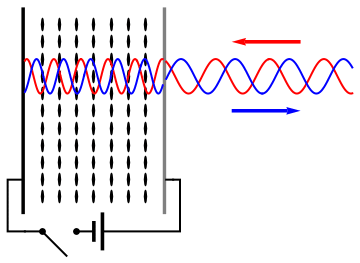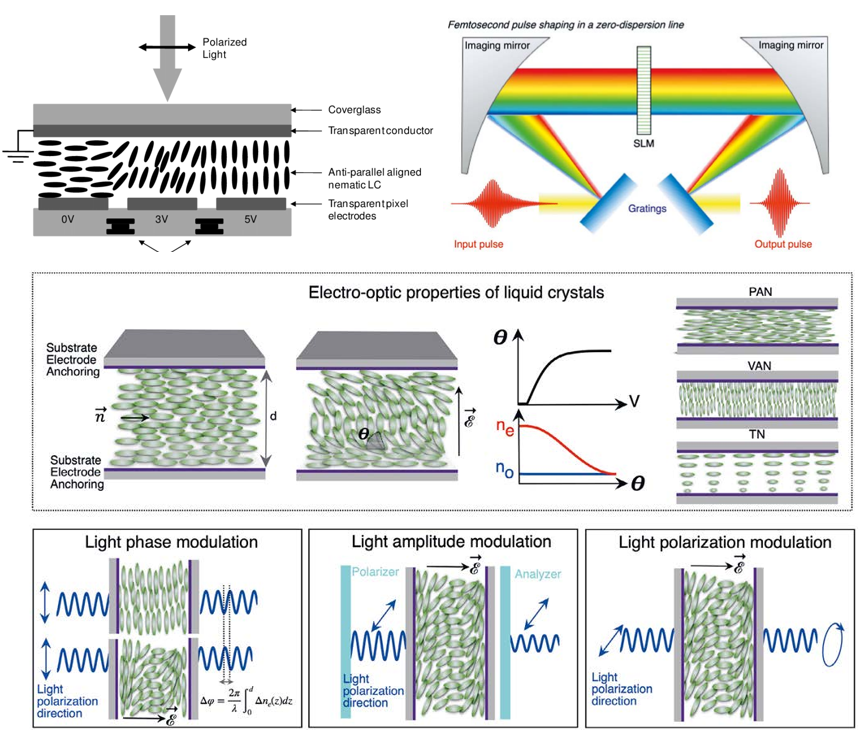器件
Lock-in-amplifier and Optical Chopper (锁相放大器和斩波器)
(lock-in amplifier)
Spatial Light Modulators (空间光调制器,SLM)
 空间光调制器(Spatial Light Modulator,SLM),是一种可以对光的相位、振幅、偏振等进行调制的器件。它是由许多独立单元(像元)组成的一维或二维阵列,这些独立单元可以单独接收光信号或电信号的控制,从而实现光调制的目的。
空间光调制器(Spatial Light Modulator,SLM),是一种可以对光的相位、振幅、偏振等进行调制的器件。它是由许多独立单元(像元)组成的一维或二维阵列,这些独立单元可以单独接收光信号或电信号的控制,从而实现光调制的目的。

- 投影仪 (projector):SLM用来modulates the intensity of the light beam.
- 全息信息存储 (holographic data storage):SLM用来encode information into a laser beam similarly to way a transparency does for an overhead projector.
- 全息显示(holographic display technology):
- 全息光学镊子(holographic optical tweezers):
参考资料:
(1) Pulse Shapers-Encyclopedia
(2) Spatial Light Modulation as a Flexible Platform for Optical Systems
Silicon Dectors
Si-PMT/(EM)CCD/CMOS
CCD
CCD是 Charge Coupled Device的缩写, it enable direct connections between an object's incoming photons and its image on a computer. 它是基于光电效应来工作的,如果入射光子有足够的能量撞击原子的outer shell上的电子,那么能量就会转移给电子并使其逸出成为free atom。
CCD采用的是thin wafer of silicon to produce electrons from photons,因为:
- free a silicon electron所需的最低能量为1.1 eV,对应于近红外光1130 nm;
- 我们前面提到的Silicon (Si) Windows的近红外透过窗口是在1.2 - 7μm范围;
- 注意其实这个个能量就是对应大家熟知的Si的禁带宽度1.12 eV,这是室温下的数值,温度变化一点,该数值基本保持稳定;
- it doesn’t start reflecting light instead of absorbing it until it reaches over 4.1 eV,对应于大约300 nm的UV光。
- 对可见光区以及部分近红外和紫外,都有很好的响应。

一个很小的 positively charged的电容贴合在硅片下面以收集由于光电效应而逸出的光子。如果每一个入射光子产生的自由电子都能被电容捕获,那么量子效率就为100 %。目前质量最好的CCD的量子效率可达90 %,注意人眼用于夜视的rod cell(视杆细胞,比能区分颜色的视锥细胞对光纤更敏感)的量子效率只有1 %。
The phonons start producing electrons as soon as the shutter is opened. The capacitor collects the freed electrons until the shutter is closed. At that point, the voltage across the capacitor represents the number of electrons the capacitor collected. This information is sent to the computer.
参考资料:
(1) CCD图像传感器——颠覆人类记录影像的方式-返朴
(2) 从光子到电子,图像传感器技术简介
(3) 带你认识现代感光器件——CCD、EMCCD、CMOS和sCMOS (中国物理学会期刊网)
(4) Classroom Aid - Charge Coupled Device (CCD)-油管视频 对应文本
Hamamatsu Avalanche Photodiodes
其他
Cleaning Optics
光学元件lenses, mirrors, filters, or gratings等等,没有universally correct cleaning method,只有一些注意事项。
There are a variety of cleaning products and cleaning methods to use depending upon the type of optic to be cleaned and the nature of the care needed, ranging from removing dust to smudges on the surface. Products such as Pick-Up Tools, Tweezers, Gloves, Compressed Air, Cotton-Tipped Swabs, Lens Tissue, Lens Cleaners, Reagent-Grade Isopropyl Alcohol, Reagent-Grade Acetone, and De-Ionized Water can be used to ensure a long product lifetime. Each type of cleaning product has its own unique benefit: Pick-Up tools and Tweezers are useful for holding optics in place while cleaning, Gloves provide a protective barrier to optics from any moisture or oils on your hands, Compressed Air effectively removes surface dust without directly contacting any coating an optic may have, Cotton-Tipped Swabs and Lens Tissue offer an effective means to wipe away any dirt without scratching an optic, and Lens Cleaners, Reagent-Grade Isopropyl Alcohol and Acetone, and De-Ionized Water each safely clean an optic.
An important point to stress is that you should NEVER clean plastic optics or optics in plastic housings with Acetone because it will damage the plastic. Therefore, if you have a plastic optic, then you should use Compressed Air, Reagent-Grade Alcohol, or De-ionized Water. If you are unsure about the type of optic that you have or the reactivity of your optical substrate or coating, then using De-Ionized Water and a little bit of dish soap is the safest way to make sure the optic is not damaged by harsh chemicals.
Rare Earth materials used in optics
- Lanthanum is used in many high index glasses; high index glass, when combined with other glass materials, improves dispersion and is utilized in many achromats and imaging lenses to increase efficiency and improve image quality.
- Cerium can be found in some of the polishing compounds used in the manufacturing process of optical glass.
- Many other optical components and electro-optical devices are also affected, such as night-vision goggles and imaging sensors which rely on rare earths including lanthanum, gadolinium, and yttrium.
